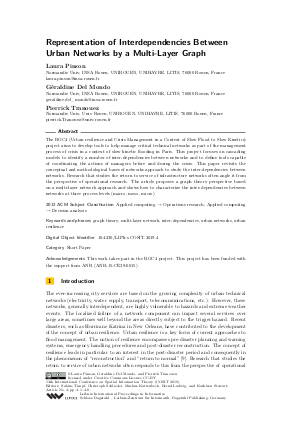Representation of Interdependencies Between Urban Networks by a Multi-Layer Graph (Short Paper)
Authors Laura Pinson, Géraldine Del Mondo, Pierrick Tranouez
-
Part of:
Volume:
14th International Conference on Spatial Information Theory (COSIT 2019)
Part of: Series: Leibniz International Proceedings in Informatics (LIPIcs)
Part of: Conference: Conference on Spatial Information Theory (COSIT) - License:
 Creative Commons Attribution 3.0 Unported license
Creative Commons Attribution 3.0 Unported license
- Publication Date: 2019-09-03
File

PDF
LIPIcs.COSIT.2019.4.pdf
- Filesize: 0.72 MB
- 8 pages
Document Identifiers
Subject Classification
ACM Subject Classification
- Applied computing → Operations research
- Applied computing → Decision analysis
Keywords
- graph theory
- multi-layer network
- inter-dependencies
- urban networks
- urban resilience
Metrics
- Access Statistics
-
Total Accesses (updated on a weekly basis)
0Document
0Metadata
Abstract
The RGC4 (Urban resilience and Crisis Management in a Context of Slow Flood to Slow Kinetics) project aims to develop tools to help manage critical technical networks as part of the management process of crisis in a context of slow kinetic flooding in Paris. This project focuses on cascading models to identify a number of inter-dependencies between networks and to define tools capable of coordinating the actions of managers before and during the crisis. This paper revisits the conceptual and methodological bases of networks approach to study the inter-dependencies between networks. Research that studies the return to service of infrastructure networks often angle it from the perspective of operational research. The article proposes a graph theory perspective based on a multi-layer network approach and shows how to characterize the inter-dependencies between networks at three process levels (macro, meso, micro)
Cite As Get BibTex
Laura Pinson, Géraldine Del Mondo, and Pierrick Tranouez. Representation of Interdependencies Between Urban Networks by a Multi-Layer Graph (Short Paper). In 14th International Conference on Spatial Information Theory (COSIT 2019). Leibniz International Proceedings in Informatics (LIPIcs), Volume 142, pp. 4:1-4:8, Schloss Dagstuhl – Leibniz-Zentrum für Informatik (2019)
https://doi.org/10.4230/LIPIcs.COSIT.2019.4
BibTex
@InProceedings{pinson_et_al:LIPIcs.COSIT.2019.4,
author = {Pinson, Laura and Del Mondo, G\'{e}raldine and Tranouez, Pierrick},
title = {{Representation of Interdependencies Between Urban Networks by a Multi-Layer Graph}},
booktitle = {14th International Conference on Spatial Information Theory (COSIT 2019)},
pages = {4:1--4:8},
series = {Leibniz International Proceedings in Informatics (LIPIcs)},
ISBN = {978-3-95977-115-3},
ISSN = {1868-8969},
year = {2019},
volume = {142},
editor = {Timpf, Sabine and Schlieder, Christoph and Kattenbeck, Markus and Ludwig, Bernd and Stewart, Kathleen},
publisher = {Schloss Dagstuhl -- Leibniz-Zentrum f{\"u}r Informatik},
address = {Dagstuhl, Germany},
URL = {https://drops.dagstuhl.de/entities/document/10.4230/LIPIcs.COSIT.2019.4},
URN = {urn:nbn:de:0030-drops-110962},
doi = {10.4230/LIPIcs.COSIT.2019.4},
annote = {Keywords: graph theory, multi-layer network, inter-dependencies, urban networks, urban resilience}
}
Author Details
Acknowledgements
This work takes part in the RGC4 project. This project has been funded with the support from ANR (ANR-15-CE39-0015)
References
-
Michael Batty. A new theory of space syntax, 2004.

-
Stefano Boccaletti, Ginestra Bianconi, Regino Criado, Charo I Del Genio, Jesús Gómez-Gardenes, Miguel Romance, Irene Sendina-Nadal, Zhen Wang, and Massimiliano Zanin. The structure and dynamics of multilayer networks. Physics Reports, 544(1):1–122, 2014.

-
Paolo Bocchini and Dan M Frangopol. Restoration of bridge networks after an earthquake: Multicriteria intervention optimization. Earthquake Spectra, 28(2):426-455, 2012.

-
Sergey V Buldyrev, Roni Parshani, Gerald Paul, H Eugene Stanley, and Shlomo Havlin. Catastrophic cascade of failures in interdependent networks. Nature, 464(7291):1025, 2010.

-
Emanuele Cozzo, Raquel A Banos, Sandro Meloni, and Yamir Moreno. Contact-based social contagion in multiplex networks. Physical Review E, 88(5):050801, 2013.

-
Manlio De Domenico, Vincenzo Nicosia, Alexandre Arenas, and Vito Latora. Structural reducibility of multilayer networks. Nature communications, 6:6864, 2015.

-
Ian Dobson, Jie Chen, JS Thorp, Benjamin A Carreras, and David E Newman. Examining criticality of blackouts in power system models with cascading events. In Proceedings of the 35th annual Hawaii international conference on system sciences, pages 10-pp. IEEE, 2002.

-
MEDD (Ministère de l’Environnement et du Développement Durable. Réduire la vulnérabilité des réseaux urbains aux inondations, 2005.

-
Yan Guo. Urban resilience in post-disaster reconstruction: Towards a resilient development in Sichuan, China. International Journal of Disaster Risk Science, 3(1):45-55, 2012.

-
Zhi-Hua Hu and Zhao-Han Sheng. Disaster spread simulation and rescue time optimization in a resource network. Information Sciences, 298:118-135, 2015.

-
R Kanawati. Co-authorship link prediction in multiplex bibliographical networks. In Multiplex network workshop-European conference on complex systems (ECCS’13), 2013.

-
Serge Lhomme. Analyse théorique et quantitative de la remise en service de réseaux d’infrastructures: définition d’un cadre d’analyse fondé sur les propriétés structurelles de ces réseaux. In Treizièmes rencontres Théo Quant, 2017.

-
Timothy C Matisziw, Alan T Murray, and Tony H Grubesic. Strategic network restoration. Networks and Spatial Economics, 10(3):345-361, 2010.

-
Céline Rozenblat. Approches multiplexes des systèmes de villes dans les réseaux d’entreprises multinationales. Revue d’Économie Régionale & Urbaine, page 393–424, 2015.

-
Marie Toubin. Améliorer la résilience urbaine par un diagnostic collaboratif, l'exemple des services urbains parisiens face à l'inondation. PhD thesis, Université Paris-Diderot-Paris VII, 2014.

-
Brian Walker, Crawford S Holling, Stephen Carpenter, and Ann Kinzig. Resilience, adaptability and transformability in social-ecological systems. Ecology and society, 9(2), 2004.

